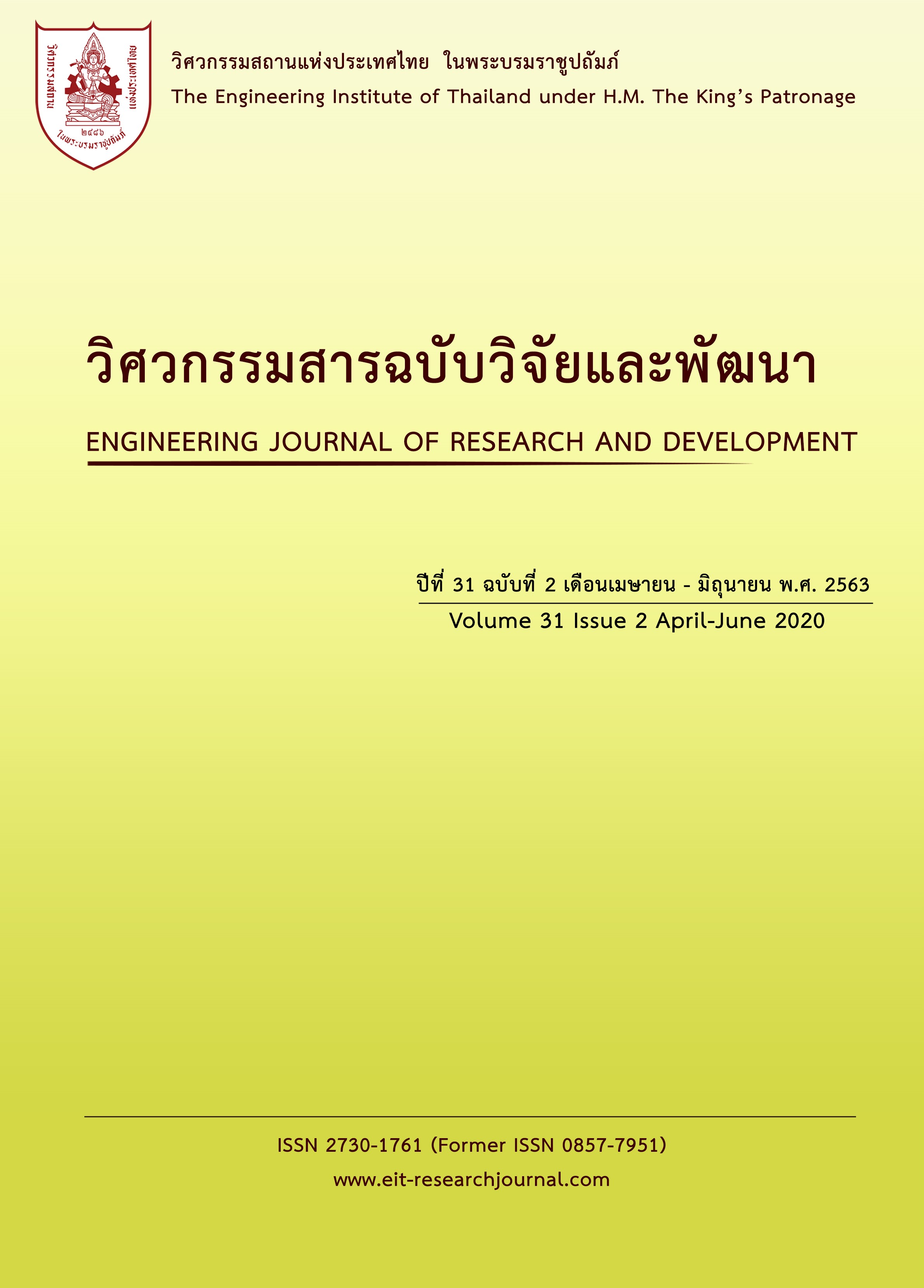APPLYING OF WATER MIST SYSTEM TO INCREASE PERFORMANCE OF AIR-COOLED HEAT EXCHANGERS IN PETROCHEMICAL INDUSTRY
Main Article Content
Abstract
The performance of air-cooled heat exchangers in the condensate residue production of petrochemical plants had been reduced, resulting in not being able to reduce the temperature of the condensate residue as specified. Therefore, water mist systems had been applied to heat exchangers to help increase heat exchange performance. The hypothesis of the research was then the water mist system could reduce the inlet air temperature of the heat exchanger and make it able to handle more heating loads. The experiment to find the optimum conditions of the water mist system was conducted. There were factors of interest; 1) the water pressure of the water mist system 2) the air pressure of the water mist system, and 3) the amount of water mist nozzles. The results showed that the optimum condition was as follows: water pressure of the water mist system of 6 bars, air pressure of the water system of 2 bars and 16 spray nozzles. Then the inlet temperature of the air-cooled heat exchanger could be reduced in the range of 2.31 to 2.41 OC with a 95% confidence level and consequently, the heat exchange performance increased to 129.91 kW or 3.84%. When applying this condition in the production process model, the yield of the production process increased from 84 to 87 tons/hour, therefore, increased 3.45%.
Article Details

This work is licensed under a Creative Commons Attribution-NonCommercial-NoDerivatives 4.0 International License.
The published articles are copyright of the Engineering Journal of Research and Development, The Engineering Institute of Thailand Under H.M. The King's Patronage (EIT).
References
American Petroleum Institute. API 661: 2012. Petroleum, Petrochemical, and Natural Gas Industries - Air cooled Heat Exchanger, Washington
D.C.: API Publishing Services, 2012
GIAMMARUTI, R. Performance Improvement to Existing Air-Cooled Heat Exchanger. In: 2004 Cooling Technology Institute Annual
Conference, Houston, 2-11 February 2004, pp. 1-15.
Liehui X., Zhihua G., Lijun Y. and Xiaoze D. Numerical study on performance improvement of air-cooled condenser. International Journal of
Heat and Mass Transfer, 2018, 125, pp. 1028–1042.
Tissot J., Boulet P., Trinquet F., Fournaison L. and Macchi-Tejeda H. Air cooling by evaporating droplets in the upward flow of a condenser.
International Journal of Heat and Mass Transfer, 2011, 50, pp. 2122–2131.
Ellmer, M. Reducing Air Cooler Size in Design Stage by Using a Chilling System. Hydrocarbon Asia, 2010, 10/12 (03), pp. 50 – 54.
Fahmy M. and Nabih H. Impact of ambient air temperature and heat load variation on the performance of air-cooled heat exchangers in propane
cycles in LNG plants – Analytical approach. Energy Conversion and Management, 2016, 212, pp. 22-35.
Yang J., Chan K., Wu X., Yang X. and Zhang H. Performance enhancement of air-cooled chillers with water mist: Experimental and analytical
investigation. Applied Thermal Engineering, 2012, 40, pp. 114-120.
Mahae N., Awapak D. and Pichairat D. Optimizetion of high protein content protein hydrolysate extraction from hard clam (meretrix casta)
using response surface methodology. KKU Science Journal, 2017, 43 (3), pp. 425-438.
Van Rooyen J. and Kröger D. Performance Trends of an Air-Cooled Steam Condenser Under Windy Conditions," J. Eng. Gas Turbines Power
Trans. ASME, 130 (2),2008,pp. 295-301
An American National Standard. ASME PTC 30: 1991. Air Cooled Heat Exchanger Performance Test Code, New York, American Society of
Mechanical Engineers, 1991.
Gates Corporation. Belt Maintenance Guide & Installation Method. for customer internal use only, 2018.
Yu F., Ho W., Chan K. and Sit R. Theoretical and experimental analyses of mist precooling for an air-cooled chiller. Applied Thermal
Engineering, 2018, 130, pp. 112 – 119.
Ellmer, M. How to improve air cooler vacuum steam condensers performance in the field. In: POWER-GEN EUROPE 2012, KoelnMesse,
Cologne, 12-14 June 2012.
Montgomery, D.C. Design and Analysis of Experiments, 9th edition. John Wiley & Sons Inc., 2018.
Turbo Mech (Thailand) Co., Ltd. DRY ONLINE CLEANING FOR AIR COOLED HEAT EXCHANGERS. Available from: http://www.turbo-
mech.co.th/?page_id=874 [18 Apr 2018].
KYORITSU GOKIN Co., Ltd. Mini Mist Nozzle Internal mixing type. Available from: https://www.everloy-spray-nozzles.com/en/product/pdf
/e/E17-18.pdf [18 Apr 2018].
Dayco Products, LLC. How do timing belts wear?, 5 Jun 2014. Available: http://www.daycoproducts.com/how-do-timing-belts-wear. [23 May
.
Enggcyclopedia. Heat exchanger fouling, Sep 2019. Available: https://www.enggcyclopedia.com/2019/05/heat-exchanger-fouling/. [6 June
.


